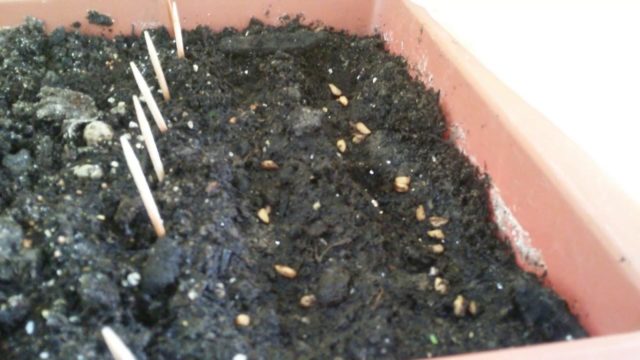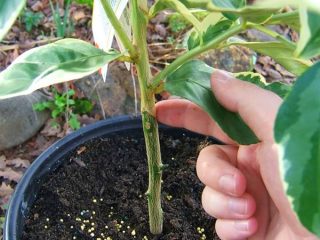Content
- 1 Is it possible to grow pomegranate from a seed?
- 2 Choosing a variety for growing pomegranate in a pot
- 3 Conditions for growing pomegranate from seeds at home
- 4 How to grow pomegranate from seed
- 5 How many pomegranates sprout?
- 6 What does a pomegranate sprout look like?
- 7 When to replant a pomegranate grown from a seed?
- 8 Will a pomegranate grown from a seed bear fruit?
- 9 Conclusion
Pomegranate is the fruit of the pomegranate tree, which has been known since ancient times. It was called the "imperial fruit" in the palace grounds of Rome, and was also called the "grain apple" due to its unusual structure. Growing pomegranate from seeds at home is associated with certain difficulties, but it is a completely doable task.
Is it possible to grow pomegranate from a seed?
To the question whether it is possible to grow pomegranate from seeds at home, the answer depends on many components of the process. For cultivation, you should choose suitable fruits, as well as observe the growing conditions.
Many collectors of exotic plants practice growing decorative pomegranates at home. This means that the tree does not produce edible fruit, but does have the characteristics of a pomegranate.The process of cultivating a decorative species differs in many respects and is the cultivation of a conventional type of indoor plant.
A pomegranate tree from a seed begins to bear fruit at home if all the rules are followed, and also, depending on the type of seed material. There are some subtleties here:
- planting material purchased from nurseries bears fruit in the 3rd year after planting;
- seeds and grains from pomegranate purchased at the market or supermarket - in the 7th year of existence.
Choosing a variety for growing pomegranate in a pot
The type of ordinary pomegranate, which is grown in specially designated areas, has several different varietal varieties:
- Azerbaijani variety Gyulosha. The fruits of this variety have thin skin, juicy and dense grains. They are characterized as sweet and sour with a predominance of acid;
- Nikitinsky early. It is distinguished by large, juicy and sweet fruits;
- Dwarf. Home cultivation of dwarf pomegranate from seeds allows you to obtain fruits weighing up to 100 g;
- Bala-mursal. This variety has fruits that grow up to 500 g. Growing such a pomegranate at home will be long and problematic.
Conditions for growing pomegranate from seeds at home
The ideal picture that appears in one’s imagination when one mentions growing pomegranate from a seed at home is one of the morning, when you can go to the pot, pick a ripe fruit, break it and enjoy the taste. In this case, you can simply consume grains, add them to salads, desserts, make juice and much more. The use of the fruit is diverse, and its beneficial properties are undeniable.
Growing from seeds is a long and labor-intensive process.After planting, pomegranate needs to create optimal conditions. Particular attention is paid to temperature conditions. At each stage of growing pomegranate from seeds, the regime should be different.
Development stage | Optimal temperature |
Bloom | From +20 °C, but not higher than +25 °C. |
Fruit formation | From +16 °C to +20 °C. |
Rest period | +10 °C or +12 °C. |
When air temperatures drop to -5 °C, the pomegranate will freeze and stop growing. When the temperature rises above +25 °C, the plant reacts by falling leaves. In addition, pomegranate sheds its leaves in the fall, as it is a deciduous crop. During the dormant period, pots of pomegranates can be placed on glazed verandas or balconies. Pomegranate tolerates changes in its growing location very well.
In order to maintain temperature conditions during cultivation, it is necessary to take measures to reduce the air temperature, provided that heating is available in winter and autumn.
Planting a pomegranate from a seed at home involves setting up artificial light and controlling natural light. To develop, pomegranates need about 12 hours of daylight. In winter, artificial lighting is installed. In summer, leaf plates must be protected from direct exposure to rays to prevent the formation of burns.
When grown at home from seeds, pomegranate requires additional feeding during the growing season. They are introduced according to a predetermined scheme:
- in spring - mineral complexes with a high nitrogen content;
- in summer - mixtures with a high content of potassium and phosphorus.
For pomegranate, mixtures intended for flower crops with a high potassium content are used.
Watering for homemade pomegranate is carried out in compliance with all requirements. Overflows and droughts are dangerous for this type of indoor tree:
- during the spring period, excluding the dormant stage, pomegranate is watered once weekly;
- The reason for the next irrigation should be the condition of the top layer of soil: if it is completely dry, crusting and clumping, watering is required.
In the early stages of pomegranate growth, the soil and tree are sprayed with a spray bottle, then watering is started with a watering can with a diffuser so as not to wash away the soil with pressure.
Humidity is increased by additionally spraying the air next to the pomegranate, as well as by placing containers filled with water around the pot.
How to grow pomegranate from seed
Growing pomegranate from seeds step by step begins with selecting soil and containers. The process of tree development depends on this.
Landing capacity
For planting pomegranates, choose a shallow pot with a narrow base and widening towards the top. For planting seeds, a plastic container may be a suitable option, but when purchasing a clay pot, you can solve several problems at once. A clay pot is able to absorb excess moisture due to the characteristics of the material. It is not advisable to purchase pots made of wood. At this stage of development, a container is chosen, which can later, when the root system increases, be replaced with a larger one.
Containers for planting pomegranates take into account the need to create a drainage layer. They must also be equipped with drainage holes. In this case, the pot should have a low tray.
Soil for pomegranate at home
The soil for natural growth of wild pomegranate may be poor and devoid of moisture, but this option is not suitable for the home. The soil is selected according to several criteria:
- The lower drainage part consists of expanded clay or vermiculite. It is laid in a layer of at least 5-6 cm. Drainage at home is an important agrotechnical technique. It allows you to control the amount of moisture, reduces the possibility of overflow, absorbing excess.
- The main part may consist of loam, peat and sand. The ratio of the components should make the soil loose, water- and moisture-permeable.
One option is a universal substrate that is used for flowering plants.
Preparing seeds for planting
When answering the question of how to grow pomegranate from a seed at home, gardeners are asked to consider the process step by step. It starts with proper preparation of planting material. In this case, the purchased pomegranate must meet the basic requirements: not be damaged and be of a sufficient degree of maturity.
- The pomegranate is cut and the contents are removed from the peel.
- The grains are cleaned, carefully freeing them from pulp. The result should be light-colored seeds without pink-red pulp particles.
- The grains are washed under low pressure of warm water.
- Pour a solution of a biogrowth stimulator for soaking for 12 hours.
How to plant a pomegranate from a seed
Planting pomegranate seeds is carried out according to the established scheme. The soil is moistened with warm, settled water, and its upper part is loosened. The seeds are buried 1.5 cm, with the sharp part down. Too much deepening can lead to inhibition of rooting; shallow planting can cause slow emergence of seedlings.In order not to make a mistake when planting pomegranates from seeds at home, experts recommend watching photos or videos of plantings.
After placing the planting material, the containers are covered with plastic wrap or covered with glass. Afterwards, they are left to root on a windowsill with sufficient light.
Seedling care
When the first shoots appear, the additional cover is removed and left on a lighted windowsill. To ensure that the sprouts sprout evenly, do not stretch out and do not stop growing, there must be enough light for the containers.
The soil is sprayed with warm water from a spray bottle. When 2 - 3 true leaves grow, mandatory picking is carried out, and the seedlings are transplanted. Containers for transplantation should be 2 - 4 cm larger than the previous ones. Weak shoots are removed. When the 4th pair of leaves appears, the top is pinched to make the young tree stronger. When flowers first appear, they are removed, since the pomegranate will not be able to set fruit due to insufficient ripeness and will lose vigor.
How many pomegranates sprout?
The timing of emergence depends on when the grains were sown. Spring and autumn plantings can sprout in 14 - 20 days. When planting in winter, the time period increases. At the end of two months, it should be recognized that the grains have not sprouted.
What does a pomegranate sprout look like?
Pomegranate sprouts in appearance resemble to many ordinary vegetable sprouts. As they grow, they stretch out, forming a thin but dense main stem with symmetrically growing leaf blades.
When to replant a pomegranate grown from a seed?
The main rule when growing pomegranate is the regularity of transplants. Until 4 - 5 years old, the tree is replanted annually.To do this, choose a more spacious container, taking into account the structural features of the tree.
The first transplant takes place in spring or autumn when the plant reaches 15 cm in height and has 8 pairs of leaves. This will be a transplant of an adult, rooted, strong tree. For it, the transshipment method is chosen so as not to disturb the root system. The sprout is transferred to a new drainage part with a lump of earth, without straightening or cutting the roots.
Will a pomegranate grown from a seed bear fruit?
If you follow the basic care rules, a pomegranate grown from a seed at home will bear fruit in the 5th to 7th year of its existence. The exact timing depends on the variety and numerous additional factors.
Flowering in the first year of growing pomegranate from seeds indicates that the plant is sufficiently strong. But for further fruiting, the flowers are removed. In the second year, up to 3 ovaries are left, focusing on the size of the tree. In the third year, the number of remaining ovaries is increased to 5 - 6. This is one of the features of growing pomegranate at home.
Conclusion
Growing pomegranate from seeds at home is associated with certain difficulties. To grow, the tree needs additional and constant lighting. In addition, it can be difficult for gardeners to set a special temperature regime for termination. The wait for fruiting lasts for several years. But the appearance of fruits becomes a real holiday. The advantage of growing pomegranate at home is the ability to get healthy fruits without adding industrial chemical additives.

















